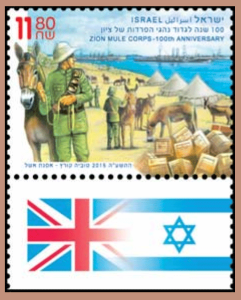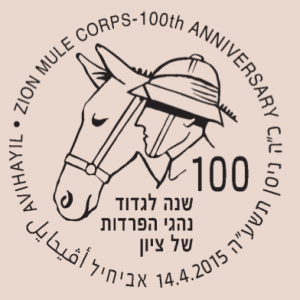[press release]
The Founding of the Mule Corps
 At the onset of WWI, the Turks who ruled Eretz Israel expelled all citizens of enemy countries who refused to become Ottoman subjects. Many of those expelled were Jews who had come from Russia before the war and nearly 11,000 of them made their way to the Egyptian city of Alexandria, which was under British rule.
At the onset of WWI, the Turks who ruled Eretz Israel expelled all citizens of enemy countries who refused to become Ottoman subjects. Many of those expelled were Jews who had come from Russia before the war and nearly 11,000 of them made their way to the Egyptian city of Alexandria, which was under British rule.
Ze’ev Jabotinsky, who came to Alexandria from Russia as a military correspondent in early December 1914, proposed founding a volunteer Jewish combat battalion that would participate in the efforts to conquer Eretz Israel from the Turks. Aided by Joseph Trumpeldor, who had come to Alexandria after being expelled from Eretz Israel, he recruited some 200 young Jews from among the expelled as well as the local Egyptian Jewish community. Participants in a meeting held on March 5, 1915 signed a binding agreement to serve in the battalion.
Although the British refused to establish a Jewish combat unit, they did agree to form a transport corps of Jewish mule drivers. Disappointed, Jabotinsky left Egypt and travelled to London to continue to promote the idea of a Jewish combat battalion. Trumpeldor, on the other hand, accepted the British proposition and volunteered to help establish the corps.
On April 1, 1915 the members of the Zion Mule Corps, or as they were known “The Mule Corps”, were sworn in. Anglo-Irish Lt. Colonel John Henry Patterson was appointed to command the corps and Joseph Trumpeldor became his second-incommand.
The Corps on the Gallipoli Front
In April 1915, a large British military force landed on the shores of the Gallipoli peninsula, not far from the city of Istanbul, the capital of the Ottoman Empire. On April 16, 1915, after only a brief twoweek training period, the Mule Corps joined the main force which had landed on the southern shore of Gallipoli. The stamp is adapted from a photo of the Mule Corps soldiers as they came ashore in Gallipoli.
 It quickly became apparent that the British action on the Gallipoli peninsula was a failure. The Turks fought fearlessly and the invading forces suffered heavy casualties. The Mule Corps soldiers, who transported ammunition and supplies to the troops on the front line, executed their difficult and wearing job very well. Despite the danger and the terrible conditions, the Jewish volunteers persevered under fire, in the mountainous terrain of the peninsula, until the British withdrawal and departure from Gallipoli on the night of January 1, 1916. During this period the Corps suffered nine casualties and approximately 50 of its men were wounded. Ninety men were present at the final parade before the British departure, approximately 25% of the original force, and only 11 of them were among the volunteers who had come ashore on April 27, 1915.
It quickly became apparent that the British action on the Gallipoli peninsula was a failure. The Turks fought fearlessly and the invading forces suffered heavy casualties. The Mule Corps soldiers, who transported ammunition and supplies to the troops on the front line, executed their difficult and wearing job very well. Despite the danger and the terrible conditions, the Jewish volunteers persevered under fire, in the mountainous terrain of the peninsula, until the British withdrawal and departure from Gallipoli on the night of January 1, 1916. During this period the Corps suffered nine casualties and approximately 50 of its men were wounded. Ninety men were present at the final parade before the British departure, approximately 25% of the original force, and only 11 of them were among the volunteers who had come ashore on April 27, 1915.
The End of the Mule Corps
A few months after returning to Egypt, the Mule Corps was disbanded on May 26, 1916. At Trumpeldor’s initiative, some 120 members of the corps reenlisted. They were sent to Britain, where they served as the core of the newly formed 38th Battalion of the Royal Fusiliers, the first Jewish combat unit within the framework of the British military.
Description of the First Day Cover
The First Day Cover incorporates the façade of the Beit Hagdudim (Jewish Legions) Museum – Avichail, which commemorates the memory and heroism of the members of the Jewish battalions of WWI. The quote taken from the founding declaration of the Mule Corps: “A corps of Jewish volunteers that shall make itself available to the government of England in order to participate in the liberation of Eretz Israel… every volunteer shall swear to sacrifice his strength and his life” symbolizes the courage and sacrifice of the pioneers of the first Jewish military force of the modern era.
Issue: April 2015
Stamp Size (mm): H30/W40
Plate: 979
Stamps per Sheet: 15
Tabs per Sheet: 5
Method of printing: Offset
Security mark: Microtext
Printer: Cartor Security Printing, France
Stamp & Cancellation Design: Osnat Eshel, Tuvia Kurtz
FDC design: Osnat Eshel




How can I buy stamp and FDC of this issue?
Thanks
Israel Philatelic Agency of North America
c/o IGPC
161 Helen Street, South Plainfield,
New Jersey 07080
USA
Tel. +1 908-548-8086 Fax: +1 908-822-7379
Toll free: 800 607 2799
Email ipana@igpc.com
Website: http://www.igpc.com